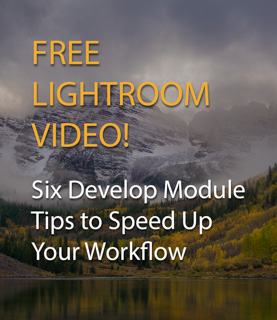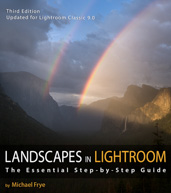In the Moment:
Michael Frye's Landscape Photography Blog
by Michael Frye | Nov 11, 2014 | Yosemite Photo Conditions

Big-leaf maples along the Merced River, yesterday afternoon
Yesterday afternoon Claudia and I drove up to Yosemite Valley to check out the fall color. We photographed the oaks in El Cap Meadow, then walked along a stretch of the Merced River that I hadn’t explored in depth before – imagine that! But conditions were right, with maples and cottonwoods adding lots of yellow color to the riverbanks. I’ve included a few photographs from yesterday above and below.
(more…)
by Michael Frye | Nov 2, 2014 | Yosemite Photo Conditions
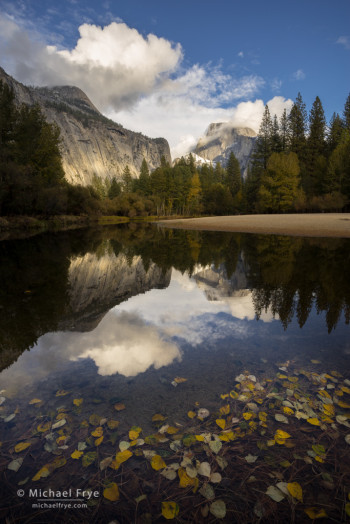
Half Dome and clouds reflected in the Merced River, Saturday afternoon
It was good to hear the rain drumming on the roof Friday night. We’ve seen occasional showers during the summer and fall, but Friday brought the first significant storm of the winter rainy season, dropping over an inch of rain in Yosemite Valley, and over a foot of snow in the high country. Everyone in California is hoping for many more storms like this over the next six months.
The storm started to clear around midday on Saturday, so Claudia and I drove up to Yosemite Valley that afternoon. It turned out to be a really beautiful afternoon in the valley, with lots of autumn color, and some great light and clouds. We found a wonderful scene near the east end of the valley, with clouds and mist-wrapped Half Dome reflected in the Merced River. I included some cottonwood leaves in the foreground to give the image a touch of autumn (right).
Early this morning we drove up to Yosemite Valley again, hoping to see fog in the meadows. We found a little mist, but not much, so we decided to go back to El Portal, which had been very foggy when we drove through. I’m glad we did. There wasn’t as much color as in Yosemite Valley, but the fog more than made up for that. I’ve included my favorite image from the morning below, with the sun breaking through the mist and silhouetting the gray pines.
(more…)
by Michael Frye | Oct 29, 2014 | Photography Tips, Vision and Creativity
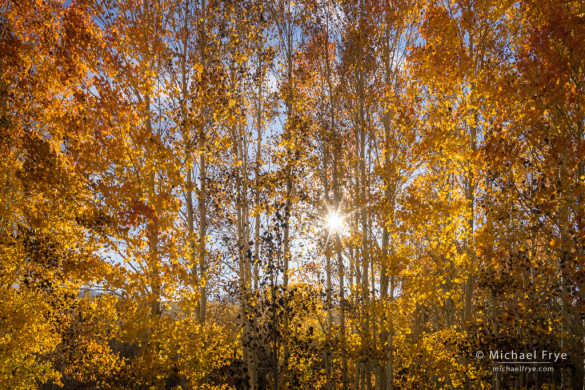
Late-afternoon sun in an aspen grove, Eastern Sierra. Backlight makes autumn leaves glow, but to avoid lens flare you have to either shade the lens (if the sun is out of the frame), or partially hide the sun behind a tree, as I did here.
Light is a vital aspect of any photograph, and always the first thing I think about when deciding where to go with my camera. The more you understand light, the better your photographs will be.
Any kind of light can work for fall color – under the right circumstances. But some kinds seem to work better than others. While photographing and leading workshops in the eastern Sierra, I was usually looking for backlight or soft light on the aspens – or best of all, soft backlight.
(more…)
by Michael Frye | Oct 27, 2014 | Announcements, Digital Darkroom
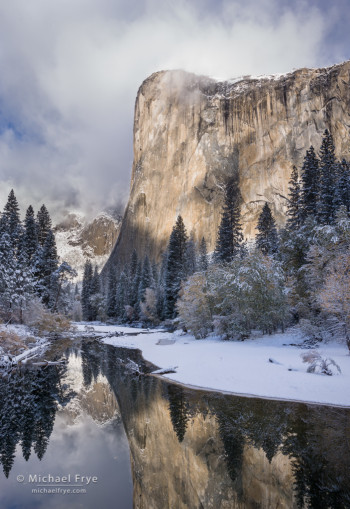
El Capitan and the Merced River after an autumn snowstorm, Yosemite. In the excerpt from Outdoor Photographer magazine I take readers step-by-step through processing this high-contrast image in Lightroom.
It’s not often that Outdoor Photographer magazine excerpts an ebook, so I was pleased when they asked to run an excerpt from my Landscapes in Lightroom 5 ebook in their December issue. Although printed copies of the magazine won’t be available until mid-November, you can already find the online version here.
The excerpt is from the fourth example in the book, showing step-by-step how I processed this high-contrast image of El Capitan in Lightroom. Due to space constraints they couldn’t run all the screen shots and illustrations from the book, but I think they did a great job of including the most essential ones.
If you don’t have the ebook yet, the Outdoor Photographer excerpt gives a good taste of what you’ll find, although of course the ebook has much more: five more step-by-step examples, in-depth discussions of the tools and workflow in Lightroom’s Develop Module, eight accompanying video tutorials (including one about using the Graduated Filter tool that goes with the excerpted chapter), and links to download the original Raw files for hands-on learning as you follow along with the examples.
To purchase the ebook, just use the Add to Cart button below, or click here to find out more.
And to everyone who has already purchased the ebook, thank you so much! I really appreciate your support, and all the kind words many of you have sent to me about the book.
— Michael Frye
Landscapes in Lightroom 5: The Essential Step-by-Step Guide
PDF ebook with video tutorials
87 double-page spreads
14.95


by Michael Frye | Oct 24, 2014 | Yosemite Photo Conditions
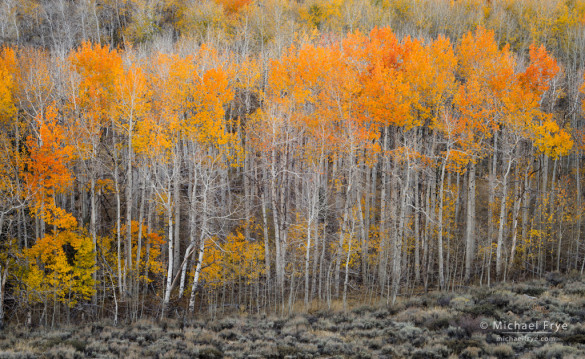
Aspens near Lee Vining, Sunday afternoon
Claudia and I got home last night after our two Eastern Sierra Fall Color workshops. We had a great time, as always. Both groups were really nice, the color was great, and some clouds added interest to sunrises and sunsets.
The color on the east side was a little early this year. When we left yesterday the lower-elevation areas like June Lake Loop, Lee Vining Canyon, and lower Lundy Canyon were at about peak. Mid- and high-elevation aspens were past peak, but you could still find colorful patches mixed with the bare trees (a photogenic combination, in my opinion). I’m sure there will still be good color in those lower-elevation spots this weekend, but probably not far beyond that.
On the drive home I made a short detour through Yosemite Valley to check on the color, and things are progressing slowly there. The bigleaf maples on the south side of the valley are starting to turn. There’s a nice patch of yellow along Southside Drive, underneath Middle Cathedral Rock (across from El Capitan). The maples in this area are perhaps 60 percent yellow and 40 percent green. Some maples near Pohono Bridge and the old dam are turning as well, but those areas are still predominantly green.
Elsewhere in the valley there’s little color so far. The oaks, cottonwoods, and dogwoods are showing just tinges of yellow and gold here and there. The maples will probably reach their peak in about a week or so, but it looks like the oaks, cottonwoods, and dogwoods won’t turn until the first or second week of November. Maybe we’ll get a dusting of snow during the peak color, like we did two years ago…
— Michael Frye
Related Posts: Back in the Sierra; Early November Magic in Yosemite
Did you like this article? Click here to subscribe to this blog and get every new post delivered right to your inbox!
Michael Frye is a professional photographer specializing in landscapes and nature. He is the author or principal photographer of The Photographer’s Guide to Yosemite, Yosemite Meditations, Yosemite Meditations for Women, and Digital Landscape Photography: In the Footsteps of Ansel Adams and the Great Masters. He has also written three eBooks: Light & Land: Landscapes in the Digital Darkroom, Exposure for Outdoor Photography, and Landscapes in Lightroom 5: The Essential Step-by-Step Guide. Michael written numerous magazine articles on the art and technique of photography, and his images have been published in over thirty countries around the world. Michael has lived either in or near Yosemite National Park since 1983, currently residing just outside the park in Mariposa, California.
by Michael Frye | Oct 14, 2014 | Yosemite Photo Conditions
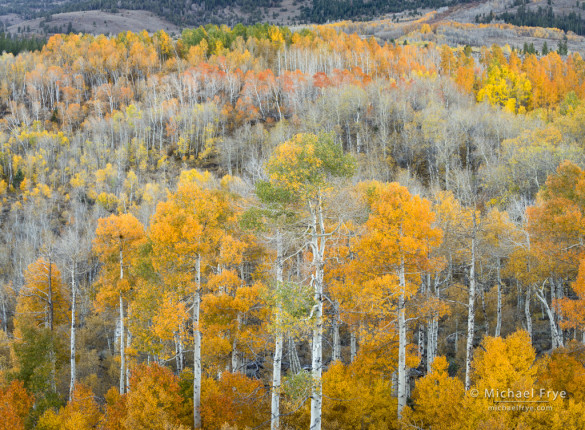
Aspen-covered hillside, yesterday afternoon, near Bridgeport, California
I’m back on the eastern side of the Sierra Nevada, my home mountains, getting ready for our upcoming workshops. There’s some great color over here. I made this photograph yesterday afternoon up near Bridgeport, and especially liked the mix of colors on this hillside, with yellow, gold, orange, and green.
Overall, the color looks pretty typical for mid-October. The higher elevation aspens are mostly bare, but the lower-elevation trees are a mix of green, yellow, and orange. The color progression might be a little earlier than average, but not much. If there’s anything unusual, it’s that some typically early-changing groves are still mostly green, while other groves that usually turn later have progressed further.
(more…)
by Michael Frye | Oct 7, 2014 | Travels and Stories
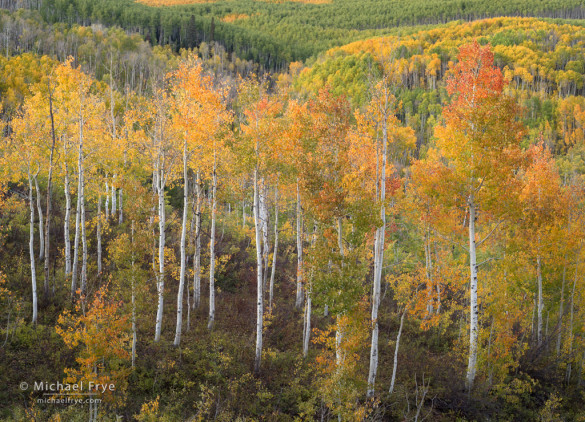
Autumn colors, Gunnison NF, CO, USA
I love photographing aspens. Their autumn color is wonderful, but it’s also those tall, straight, white trunks that make them so compelling.
It’s been a long-time dream of mine to photograph aspens in Colorado in the fall, but various obligations and commitments kept me from going. This year, however, Claudia and I found a brief time slot and decided to go. And we’re so glad we did, as it’s just beautiful here. Some high-elevation areas, like Crested Butte, are past peak, and others seem to be turning late, but we’ve found some wonderful color in several places, and an endless supply of great photo subjects. Here are some photographs from the past few days, and I’ll post more when I get a chance.
(more…)
by Michael Frye | Oct 5, 2014 | Night Photography
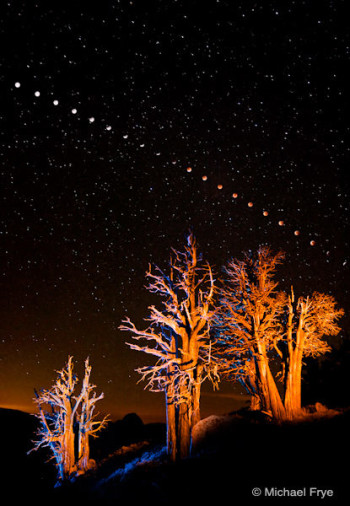
Lunar Eclipse Sequence, 1:23 a.m. to 4:49 a.m., August 28, 2007, Yosemite National Park, California
Lunar eclipses are spectacular events to see and photograph. I’ve been lucky enough to capture several lunar eclipse sequences over the years, including this one from Yosemite in August 2007.
We’re all going to get another chance at photographing an eclipse soon: a total lunar eclipse will be visible throughout North America early Wednesday morning, October 8th.
In the western half of the U.S. the entire eclipse sequence will be visible, from full moon, to partial eclipse, to total eclipse, and back to full again. In California the moon will be high in the sky to the west-southwest at the beginning of the sequence, then sink near the horizon to the west by the end of the sequence. The moon’s path will actually be somewhat of similar to path in this photograph, except that the eclipse will be higher in the sky and a bit further to the right, and the angle of the moon’s path will be steeper.
On the east coast the moon will set when its fully eclipsed, so it won’t be visible as its coming out of the eclipse. But that means the moon will be near the horizon when its fully eclipsed, where you might be able to photograph it next to an interesting foreground object as the dawn lightens the sky. It should be just north of due west as it sets.
For precise guidance about the moon’s position in relation to the landscape, I recommend consulting PhotoPills or The Photographer’s Ephemeris. Here’s the timing for the eclipse:
(more…)
by Michael Frye | Sep 23, 2014 | Yosemite Photo Conditions

Stormy sunrise at North Lake, Bishop Creek Canyon, Sunday morning
After photographing lightning near Bishop on Saturday night (see my previous post), I thought there might be some interesting clouds still hanging around on Sunday morning, so I woke early and drove up to North Lake, near the upper end of Bishop Creek Canyon.
And there were clouds – almost too many. Another small rain squall was moving up from the south along the Sierra crest, approaching Bishop Creek Canyon just as the sun was due to rise. There were enough clouds to the east that I thought they might block the light. And I think some clouds lingering over the White Mountains did block the very first sunlight, but just after sunrise some clouds started to turn color overhead, and soon the peaks began to light up as well.
It evolved quickly into a dramatic scene. It was a little breezy, rippling the water surface, but there were still nice reflections at first. Then the wind increased, so I climbed up the ridge along the eastern shore of the lake to get a different perspective, one that didn’t depend as much on reflections.
(more…)
by Michael Frye | Sep 22, 2014 | Night Photography
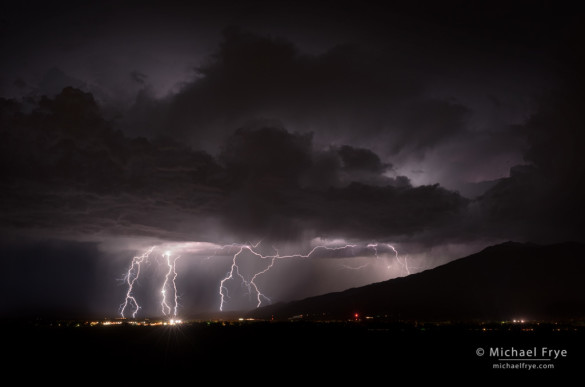
Lightning over Bishop and the Owens Valley, CA, USA
Over the weekend Claudia and I made our annual pilgrimage to the Millpond Music Festival in Bishop, over on the eastern side of the Sierra. This is the 15th consecutive year we’ve attended this festival. Hanging out with friends, listening to music underneath the high peaks of the Sierra, made for a wonderful, relaxing, fun weekend. And as a bonus, I got to photograph some interesting weather.
The land around Bishop is semi-desert, so it doesn’t get much rain. We’ve been sprinkled on a couple of times at Millpond, but had never experienced any serious rain – until Saturday.
A weak low-pressure system pulled some remnants of Hurricane Odile up from the south. Clouds and thunderstorms developed over the mountains, but missed Bishop and the Owens Valley until Saturday evening. As the second-to-last act of the day was performing, a few raindrops fell. I looked at radar images on my phone, and saw some serious-looking storm cells moving right up the valley from the south. I estimated that we had an hour or two before we got dumped on. Figuring that the last performance would be cancelled anyway, I decided to try and get some lightning photographs.
(more…)













